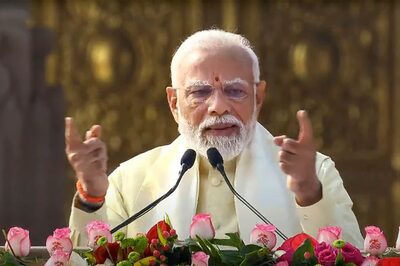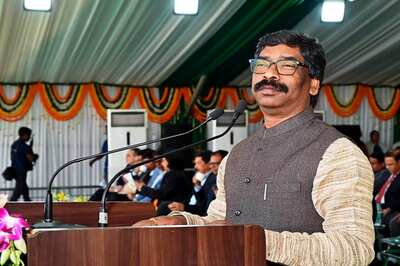
views
A careful scrutiny of Oxfam’s recent inequality report, ‘The Inequality Virus’, reflects a greater deepening of (pre)-existing wealth, income (and related social) inequalities in India, and across the world, over the last year. While the wealth of Indian billionaires increased by roughly 35 per cent during the lockdown, millions of Indians around this time went out of job, while 80 per cent households barely survived through some borrowings, as millions of others were pushed back into the black hole of poverty and further capability deprivation.
Finance Minister Nirmala Sitharaman recently stated that this year’s Union Budget will be one the likes of which Indians haven’t been seen in over 100 years. If her actions could follow her statement, this Budget could do a lot more—as against its predecessors—to address the ills of worsened inequalities, by putting more money into the hands of people who need it the most now and take a little more from the pockets of those who have only got richer, to enhance the government’s own redistributive capabilities.
Enhancing ‘redistributive capabilities’ is important for this government now, given what has been observed from the numbers of the past annual budgets. Over the last three to four years, the government has found it increasingly difficult to accrue the revenue it estimates to collect over a given fiscal year (also true for its over-ambitious disinvestment targets) and finds it equivalently difficult to spend what it says it would, especially across the different heads of essential social, public expenditure schemes (say, MGNREGA, Ujjwala, crop insurance, child nutrition plans etc. to name a few).
ALSO READ| Education Sector’s Budget 2021 Wish List: Allocating 6 Per Cent of GDP, Push to Tech-Based Solutions, Checking Dropout Rate
Despite this, India’s weak growth performance—what it was in the pre-pandemic years too—was being largely attributed to higher government spending (which was still less than what was promised or outlaid in the annual estimates), as fiscal deficit continued to expand. We still don’t know what the ‘actual’ deficit numbers look like.
So, a new budgetary arithmetic to achieve something—on February 1, 2021—that hasn’t been done in over 100 years remains puzzling, at least for now.
My (unsolicited) proposition to the Finance Minister would be to use this opportunity to do the following: a) consider generating greater redistribution- and fiscal spending capacity-capabilities by taxing the ultra-rich through a ‘Covid consumption tax’; b) use these additional resources to spend more on nutrition, health and social schemes, and more importantly spend on public works programmes that can help create more jobs in the public sector (in urban and rural areas); c) borrow wherever possible only for crowding in (private) investment possibilities, and d) establish clarity in economic vision through a medium-to-long term fiscal plan.
A Covid Consumption Tax
The idea in favour of imposing a ‘Covid consumption tax or cess’ on the ultra-rich has been discussed at length before. A Consumption Tax—for the top income class (the top 5 per cent may be)—could be first introduced as a ‘Covid Consumption Cess’, if needed. Under more normal circumstances, getting the political capital to do this might have been difficult, but not under the current (crisis) circumstances.
How would this work? A ‘consumption tax’ (or a cess) is a tax imposed on ‘consumption’, as opposed to some other measure of ability to pay, most notably ‘income’. As I have mentioned earlier: “In India, our data on consumption-based surveys (even at household levels) and trends seen within them have been observed as a principal method for understanding and analysing various kinds of inequities, and therefore, can allow policymakers to have a good idea on considering a ‘consumption tax’ that progressively accrues income from higher consumers-producers”.
“In practice too, ‘consumption’ is much easier to measure than ‘income’, and the dynamic efficiency gained from encouraging savings and investment could be large. The transitional difficulties, often associated in implementing such a system, are more likely in nations where consumption-based data and its sources are weak. In India, a relatively more robust consumption-based household data allows any such transitional costs to be minimised. For a start, in a graded implementation cycle, at least one can consider imposing a marginal consumption or spending tax side-by-side to existing income-taxes, which (if it were to me) can be phased out over time,” I have argued in my previous writings.
Create a ‘Multiplier Effect’
In a recent field study undertaken by the Centre for New Economics Studies, our field team spoke to a number of (daily-wage) workers who have seen a 50-60 per cent dip in days of work during a given month, and a 70 per cent drop on average in their daily incomes (even though their household expenses, especially transport-conveyance, have gone up).
It is imperative for this Budget to more urgently create and put money into the hands of those who need it the most. Increasing the volume and frequency of cash transfers for lower classes through existing plans is step one. For step two, there is also a strong case to reduce the rates of ‘personal income taxes’ for a two-three year fiscal window, especially for the lower (middle) income class.
Why this increased focus on fiscal spending or multiply ‘spending’ amongst lower income classes? The answer to this lies in India’s structural demand problem (discussed here). Consumption demand has been increasingly weak across income classes in India, even before the pandemic struck last year.
ALSO READ| Budget 2021: Bullet Trains to Expand Network Across Country as Govt Likely to Raise Allocation for Railways
The asymmetric growth trend has reflected—for far too long—what economic agents (households, firms, banks, government, and the external sector) in the top 10 per cent income class consume.
To address a structural problem like this, which is correspondingly linked to addressing the widened wealth and income inequality, a more comprehensive fiscal action plan is needed. However, the Union government’s fiscal actions and responses over the last seven to eight years have remained more ad-hoc, guided by ‘political’, ‘rhetorical’ reasons, which aren’t grounded in principles of ‘markets’ or in any sound economic theory/logic.
The vitality of this Budget’s response is hinged upon the current government’s ability to establish ‘clarity’ in economic action through a comprehensive three-to-five-year fiscal plan, which can lay the vision and the blueprint for India’s economic recovery to not just be rapid but more inclusive, equitable and sustainable in nature.
Read all the Latest News, Breaking News and Coronavirus News here




















Comments
0 comment